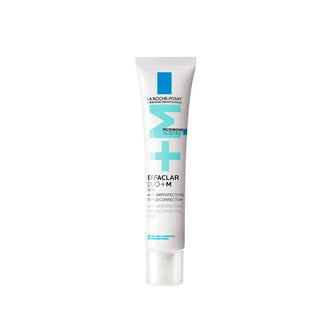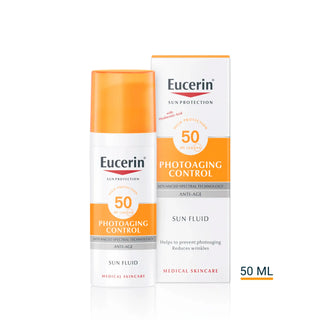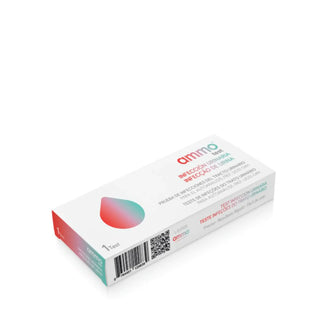Ammo Urinary Infection Test 2 Self-diagnostic test for urine detection 4 parameters: blood, nitrites, proteins and leukocytes. In this way, a urinary infection can be confirmed so that the doctor can be consulted to confirm and prescribe the appropriate treatment. UTI represents the most common disease of the urinary tract which includes the urethra, bladder, ureter and kidneys. It is more common in women because the female urethra is shorter and makes it easier for bacteria to enter the urinary tract.
- Convenience: You can take the test from the comfort of your home, at a time that suits you best.
- Speed: 3 minutes.
- Detect to act quickl.
- Easy to use.
Warnings:
- Read the instructions carefully before carrying out the test.
- For in vitro self-diagnosis only.
- Store in a dry place at 2-30°C (36-86°F), avoiding areas with excess humidity. If the packaging is damaged or opened, do not use.
- A clean container (not contaminated with cleaning fluids) to collect urine.
- Keep out of reach of children.
- Do not use after the expiration date or if the packaging is damaged.
- Strictly respect the indicated time.
- Use the test only once. Do not disassemble or touch the reagent area of the test strip.
- For external use only.
- The test must be disposed of in accordance with local regulations.
- If you have difficulty identifying the color (such as color blindness), ask for help reading the test.
Limitations
- Note: Testing for urinary tract (urine) infections may be affected by certain substances that cause abnormal urine color, such as medications containing azo pigments, nitrofurantoin, and riboflavin. Color development on the test pad may be hidden or a color reaction may occur that could be interpreted as a false result.
- Leukocytes: The result must be read within 2 minutes to allow the color to appear completely. The intensity of the color obtained is proportional to the amount of leukocytes present in the urine sample. High specific gravity or high glucose concentrations (≥ 2,000 mg/dL) may cause the result to be artificially low. The presence of cephalexin, cephalothin or high concentrations of oxalic acid can also make the result artificially low. Tetracycline can reduce reactivity and high levels of the drug can cause a false negative reaction.
- Elevated urinary protein may reduce the color intensity of the reaction. This test does not react with erythrocytes or common bacteria in urine.
- Blood: A uniform green color indicates the presence of myoglobin, hemoglobin, or hemolyzed erythrocytes. Scattered or compact green dots indicate intact erythrocytes. To improve accuracy, separate color scales are provided for hemoglobin and erythrocytes. Positive results with this test are usually seen in the urine of menstruating women. High pH urine has been reported to reduce sensitivity, while moderate to high concentrations of ascorbic acid can inhibit color formation. Microbial peroxidase, associated with urinary tract infections, can cause a false positive reaction. The test is slightly more sensitive for free hemoglobin and myoglobin than for intact erythrocytes.
- Nitrite: The test is specific for nitrite and does not react with any other substance normally excreted in the urine. Any uniform degree of pink to red should be interpreted as a positive result, suggesting the presence of nitrite. The intensity of the color is not proportional to the number of bacteria present in the urine sample. Pink dots or pink edges should not be interpreted as a positive result. Comparing the reaction area of reactants on a white background helps detect low levels of nitrites that would otherwise go unnoticed. Ascorbic acid above 30 mg/dl can cause a false negative in urine containing less than 0.05 mg/dl of nitrite ions. The sensitivity of this test is reduced with samples with highly alkaline urine or high specific gravity. A negative result does not always exclude the possibility of the presence of bacteria. Negative results may occur in urinary tract infections from organisms that do not contain reductase to convert nitrate to nitrite; when urine does not remain in the bladder long enough (at least 4 hours) for the reduction of nitrate to nitrite to occur; when receiving antibiotic treatment or when nitrate is absent from the diet.
- Protein: Any shade of green indicates the presence of protein in the urine. This test has a high sensitivity for detecting albumin, and less sensitivity for detecting hemoglobin, globulin and mucoprotein. A negative result does not exclude the possibility of the presence of these other proteins. False positive results may also be obtained with highly alkaline or buffered urine. Contamination of the urine sample with quaternary ammonium components or skin products containing chlorhexidine may result in false positives. Urine samples with high specific gravity can generate false negatives.
- Store inside the packaging at room temperature or refrigerated (2-30°C). The test is stable beyond the expiration date on the unopened package. The test must remain in the closed packaging until use.
- Do not freeze.
- Do not use after the expiration date.
- Remove from packaging. Do not touch the test fields. Once the packaging is opened, it is recommended to perform the test immediately.
- Immerse the dipstick in the urine sample. ATTENTION: Press the strip and make sure all four strips are submerged for 1-2 seconds.
- Remove the test strip and remove excess urine against the edge of the container or with some absorbent material (a paper towel, for example) to avoid mixing chemicals into adjacent reagent areas.
- Wait 2 minutes. Read the result of each parameter separately.
- Compare the color with the color chart provided.
This product has been formulated with selected ingredients and manufactured under strict quality controls to ensure its safety and effectiveness. It complies with current regulations, respecting the safety standards required for cosmetics. For safe use, avoid contact with eyes and mucous membranes, keep out of reach of children, and follow the instructions for use. Store in a cool, dry place away from direct sunlight. In case of irritation, discontinue use and consult a healthcare professional, if necessary.
The symptoms of a urinary tract infection can be very uncomfortable. They can vary depending on the severity of the condition and the part of the urinary tract affected. Carrying out the ammo test yourself allows you to act quickly if you detect a urinary tract infection.
Product composition may be subject to change. Always check the packaging for the latest ingredient information.
Ammo Urinary Infection Test 2 Self-diagnostic test for urine detection 4 parameters: blood, nitrites, proteins and leukocytes. In this way, a urinary infection can be confirmed so that the doctor can be consulted to confirm and prescribe the appropriate treatment. UTI represents the most common disease of the urinary tract which includes the urethra, bladder, ureter and kidneys. It is more common in women because the female urethra is shorter and makes it easier for bacteria to enter the urinary tract.
- Convenience: You can take the test from the comfort of your home, at a time that suits you best.
- Speed: 3 minutes.
- Detect to act quickl.
- Easy to use.
Warnings:
- Read the instructions carefully before carrying out the test.
- For in vitro self-diagnosis only.
- Store in a dry place at 2-30°C (36-86°F), avoiding areas with excess humidity. If the packaging is damaged or opened, do not use.
- A clean container (not contaminated with cleaning fluids) to collect urine.
- Keep out of reach of children.
- Do not use after the expiration date or if the packaging is damaged.
- Strictly respect the indicated time.
- Use the test only once. Do not disassemble or touch the reagent area of the test strip.
- For external use only.
- The test must be disposed of in accordance with local regulations.
- If you have difficulty identifying the color (such as color blindness), ask for help reading the test.
Limitations
- Note: Testing for urinary tract (urine) infections may be affected by certain substances that cause abnormal urine color, such as medications containing azo pigments, nitrofurantoin, and riboflavin. Color development on the test pad may be hidden or a color reaction may occur that could be interpreted as a false result.
- Leukocytes: The result must be read within 2 minutes to allow the color to appear completely. The intensity of the color obtained is proportional to the amount of leukocytes present in the urine sample. High specific gravity or high glucose concentrations (≥ 2,000 mg/dL) may cause the result to be artificially low. The presence of cephalexin, cephalothin or high concentrations of oxalic acid can also make the result artificially low. Tetracycline can reduce reactivity and high levels of the drug can cause a false negative reaction.
- Elevated urinary protein may reduce the color intensity of the reaction. This test does not react with erythrocytes or common bacteria in urine.
- Blood: A uniform green color indicates the presence of myoglobin, hemoglobin, or hemolyzed erythrocytes. Scattered or compact green dots indicate intact erythrocytes. To improve accuracy, separate color scales are provided for hemoglobin and erythrocytes. Positive results with this test are usually seen in the urine of menstruating women. High pH urine has been reported to reduce sensitivity, while moderate to high concentrations of ascorbic acid can inhibit color formation. Microbial peroxidase, associated with urinary tract infections, can cause a false positive reaction. The test is slightly more sensitive for free hemoglobin and myoglobin than for intact erythrocytes.
- Nitrite: The test is specific for nitrite and does not react with any other substance normally excreted in the urine. Any uniform degree of pink to red should be interpreted as a positive result, suggesting the presence of nitrite. The intensity of the color is not proportional to the number of bacteria present in the urine sample. Pink dots or pink edges should not be interpreted as a positive result. Comparing the reaction area of reactants on a white background helps detect low levels of nitrites that would otherwise go unnoticed. Ascorbic acid above 30 mg/dl can cause a false negative in urine containing less than 0.05 mg/dl of nitrite ions. The sensitivity of this test is reduced with samples with highly alkaline urine or high specific gravity. A negative result does not always exclude the possibility of the presence of bacteria. Negative results may occur in urinary tract infections from organisms that do not contain reductase to convert nitrate to nitrite; when urine does not remain in the bladder long enough (at least 4 hours) for the reduction of nitrate to nitrite to occur; when receiving antibiotic treatment or when nitrate is absent from the diet.
- Protein: Any shade of green indicates the presence of protein in the urine. This test has a high sensitivity for detecting albumin, and less sensitivity for detecting hemoglobin, globulin and mucoprotein. A negative result does not exclude the possibility of the presence of these other proteins. False positive results may also be obtained with highly alkaline or buffered urine. Contamination of the urine sample with quaternary ammonium components or skin products containing chlorhexidine may result in false positives. Urine samples with high specific gravity can generate false negatives.
- Store inside the packaging at room temperature or refrigerated (2-30°C). The test is stable beyond the expiration date on the unopened package. The test must remain in the closed packaging until use.
- Do not freeze.
- Do not use after the expiration date.
- Remove from packaging. Do not touch the test fields. Once the packaging is opened, it is recommended to perform the test immediately.
- Immerse the dipstick in the urine sample. ATTENTION: Press the strip and make sure all four strips are submerged for 1-2 seconds.
- Remove the test strip and remove excess urine against the edge of the container or with some absorbent material (a paper towel, for example) to avoid mixing chemicals into adjacent reagent areas.
- Wait 2 minutes. Read the result of each parameter separately.
- Compare the color with the color chart provided.
This product has been formulated with selected ingredients and manufactured under strict quality controls to ensure its safety and effectiveness. It complies with current regulations, respecting the safety standards required for cosmetics. For safe use, avoid contact with eyes and mucous membranes, keep out of reach of children, and follow the instructions for use. Store in a cool, dry place away from direct sunlight. In case of irritation, discontinue use and consult a healthcare professional, if necessary.
The symptoms of a urinary tract infection can be very uncomfortable. They can vary depending on the severity of the condition and the part of the urinary tract affected. Carrying out the ammo test yourself allows you to act quickly if you detect a urinary tract infection.
Product composition may be subject to change. Always check the packaging for the latest ingredient information.
Recommended products
Buy with guarantee that all our products are original
Talk with our expert team to advise you
All our method payments are 100% secure




